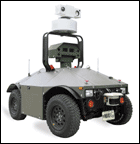Ever wish you could have someone just go around and take inventory 24 hours a day, so you would know exactly where everything is in your warehouse? The U.S. military did, so it asked General Dynamics Robotic Systems to create a
robot that uses RFID to take perpetual inventory.
The robot, fondly called MDARS (Mobile Detection Assessment Response System), has three primary missions: Patrol a location and detect intruders, ensure that designated barriers and gates are locked, and take inventory. MDARS has been in development since 1993. Indoor and outdoor versions, now in prototype, will be tested for about a year at the military’s sprawling Hawthorne Army Depot in Hawthorne, Nev. If that goes well, the Army may decide to ask General Dynamics to begin producing the robots in 2006.
The military’s main goal in developing the robot is to reduce the manpower needed to patrol its facilities. The decision was made to add RFID reading capability to allow MDARS to take inventory because the military frequently loses track of some of the millions of items it handles each year. “Something is delivered and you move something else, and pretty soon, you have no idea where the original item went,” says Brian Frederick, the MDARS program manager for General Dynamics. “This guy helps you find stuff.”
Indoors, the robot uses a combination of radar, laser and sonar to identify landmarks and determine its location (the outdoor version uses GPS) and is programmed to roll randomly through a facility. Its two antennas scan 303 MHz RFID tags on pallets, cases and items such as desks and chairs. The tags are associated with the robot’s location, and that information is stored in a database and can be compared nightly with a master database to determine if items were taken without authorization.
For now, General Dynamics is planning to sell the robot, which is expected to cost less than $200,000 each, only to the Department of Defense. But if it proves its “metal,” companies just might want an MDARS of their own.


